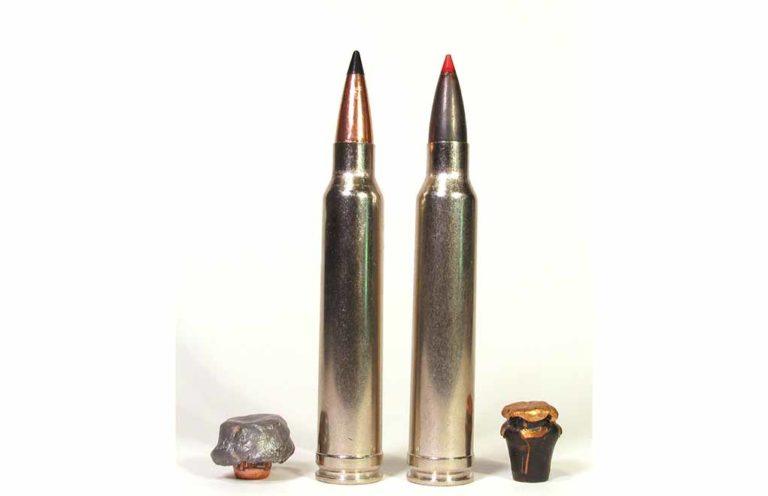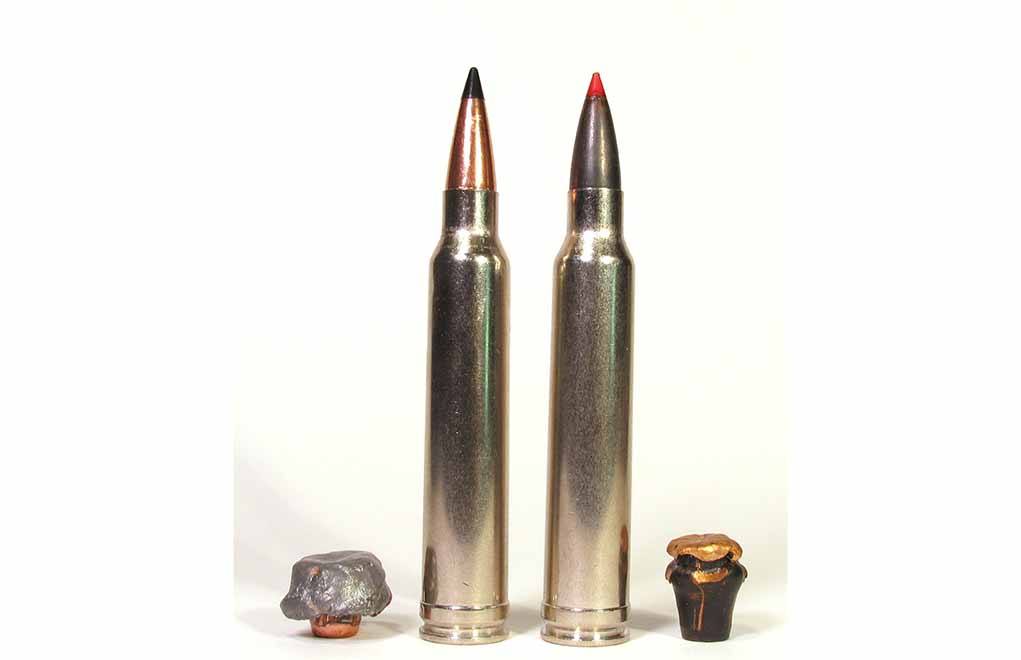

Despite common wisdom, there are some major nuances to the idea sectional density predicts how deep a bullet penetrates.
Does Sectional Density Define Penatration Potential:
- Sectional Density (SD) is the ratio of a bullet’s weight to the square of its diameter.
- if bullets of the same caliber are compared, the heaviest bullet will have the highest sectional density.
- if two bullets of identical weight but of different caliber are compared, the smaller caliber bullet will have the higher sectional density.
- Sectional density does play some role in defining a bullet's penatration potential, it is not absolute.
- A bullets toughness — resistance to deformation or fracture — has a plays a greater role in determing how much it will penatrate.
Sectional Density (SD) is the ratio of a bullet’s weight to the square of its diameter: SD equals a bullet’s weight in pounds, divided by the bullet’s diameter in inches, squared. For example:
A 180-grain, .308- caliber bullet would have a SD of .271.
180 grains / 7000 (7000 grains per pound) = .025714
.3082 (.308 x .308) = 0.094864
.025714 / .094864 = 0.2710
The Wikipedia on-line encyclopedia defines “BS” as a common English expletive most often used as a description of incorrect, misleading or false language and statements. In short, BS is what you say to your buddy as you sit around the campfire, after listening to his story about the big one that got away or the 600-yard shot he made. The formula for BS goes something like ½ Truth + ½ Fiction = BS. So, what is the connection between SD and BS?
Simply stated, if bullets of the same caliber are compared, the heaviest bullet will have the highest sectional density. It also means that if two bullets of identical weight but of different caliber are compared, the smaller caliber bullet will have the higher sectional density. A common cliché often used by gunwriters goes something like this: “All things being equal, the bullet with the highest sectional density will penetrate the deepest.”
With regard to non-deforming solids, there is some truth to this. If two identically designed .375-caliber solids impact an animal or expansion medium at the same velocity, the heaviest bullet — the one with the highest SD — will most likely penetrate the deepest. However, with expanding bullets, this is somewhat like saying that “there’s a 50 percent chance of rain” because with expanding bullets, “all things” are never equal.
“Expanding” means to increase in volume or size. Of course it also means to open or spread out, and some bullets do just that. A more appropriate explanation of the shape-shifting a bullet experiences during penetration might be “deforming,” which is defined in physics as, to alter the shape by pressure or stress. Bullets change shape during penetration due to the stress they encounter, and a bullet’s resistance to this stress equals its strength or toughness.
The toughness of a material or bullet is the maximum amount of energy it can absorb before fracturing. Bullets are built from solid materials, and solids generally have three responses to force described as elasticity, plasticity and fracture. The strength of a material or bullet is the extent of the measure of its elastic range, or elastic and plastic ranges together. Strength and toughness are products of the materials bullets are constructed of, and how they are put together, not their SD. Most bullets are a combination of copper and/or lead alloy. Bullet manufacturers influence a bullet’s reaction to energy and force by adjusting the make-up of these alloys and through the design and construction of the bullet.
Smashing Other Ballistic Myths:
- .45 ACP vs 9mm: Which Is Better?
- Are Ballistic Gel Penetration Tests Gospel?
- What You Need To Know About Handgun Stopping Power
- Bullet Expansion: Velocity Is The Deciding Factor
- The Truth About Barrel Length And Velocity
If you increase the SD of a bullet in any given caliber/cartridge, it gets heavier. Loaded within the same cartridge, an increase in bullet weight equates to a decrease in velocity. By reducing velocity, you inhibit deformation which can, depending on impact velocity, create a larger or smaller expanded frontal diameter. Impact velocity also plays a part in how much weight a bullet will loose or retain. Retained weight and the ultimate frontal diameter — in conjunction with impact velocity — determine penetration. It’s a triangle of dependency that’s continually in a state of flux and constantly influenced by each side.
As much as it sounds like it might, SD has nothing to do with how dense, tough or strong a bullet is. Two bullets constructed of entirely different materials can have the exact same sectional density but different relative densities, specific gravities or toughness.
Consider a 250-grain, .375-caliber bullet constructed of solid lead will have a specific gravity of 11.35, a 250-grain bullet made from milk chocolate will have a specific gravity of 1.08. Both have the same SD, but unless you’re hunting Easter bunnies, the lead bullet is the best choice.

The temptation to compare the SD of two bullets of a different caliber in order to make an assumption about penetration or killing ability exists, and you might often hear this discussion around the counter at your local gun shop. The fact is, regardless of weight, differences in bullet construction, impact velocity and deformation progression, make SD irrelevant.
Even when comparing bullets of the same type and caliber, you’ll find that SD alone does not dictate penetration. A test of three, .308-caliber Swift Scirocco II bullets weighing 150 grains, 165 grains and 180 grains, replicating 100-yard impact velocities of each bullet when fired from a 300 Winchester Magnum, showed a maximum variation of penetration depth of 1 inch. This works out to a 5 percent difference, and that’s within the margin of error of any expansion medium or results in actual game animals.
Further evidence that SD by itself is no indication of terminal ballistics is when you compare bullets of the same weight and caliber, but of different designs that impact at the same velocity. A test with six different 180-grain, .30-caliber bullets, from four different manufacturers, showed a penetration depth variance of as much as 27 percent. On the shallow end, a Swift Scirocco II penetrated 14.5 inches and on the deep end a Winchester XP3 penetrated 19.5 inches.
Comparing the SD of two unfired bullets is nothing more than comparing the ratio of their weight to their diameter. It’s like comparing the body-fat percentage of two boxers in an effort to determine which one will hit the hardest or win the fight. As far as penetration is concerned, the only formula you need to know that involves SD, is that SD = BS, and that’s a formula anyone can compute, even without a calculator.
Editor's Note: This article originally appeared in the March 2019 issue of Gun Digest the Magazine.

Next Step: Get your FREE Printable Target Pack
Enhance your shooting precision with our 62 MOA Targets, perfect for rifles and handguns. Crafted in collaboration with Storm Tactical for accuracy and versatility.
Subscribe to the Gun Digest email newsletter and get your downloadable target pack sent straight to your inbox. Stay updated with the latest firearms info in the industry.

![Best Concealed Carry Guns In 2025 [Field Tested] Wilson Combat EDC X9S 1](https://gundigest.com/wp-content/uploads/Wilson-Combat-EDC-X9S-1-324x160.jpg)


![Best 9mm Carbine: Affordable PCCs [Tested] Ruger Carbine Shooting](https://gundigest.com/wp-content/uploads/Ruger-Carbine-Shooting-100x70.jpg)
![Best AR-15: Top Options Available Today [Field Tested] Harrington and Richardson PSA XM177E2 feature](https://gundigest.com/wp-content/uploads/Harrington-and-Richardson-PSA-XM177E2-feature-100x70.jpg)

Kind of a silly article. No one variable will determine the amount penetration, be it diameter, weight, velocity, or sectional density. Sectional density is probably the worst example especially with expanding bullets. Once an expanding bullet hits a target the SD changes with the expansion of the bullet. But I guess writers gotta wright about something.